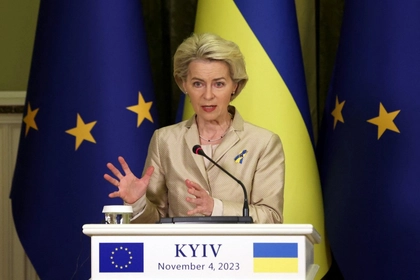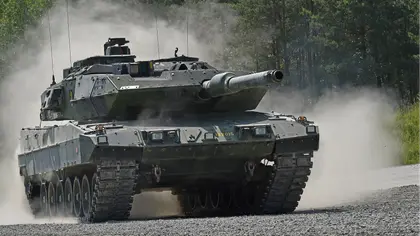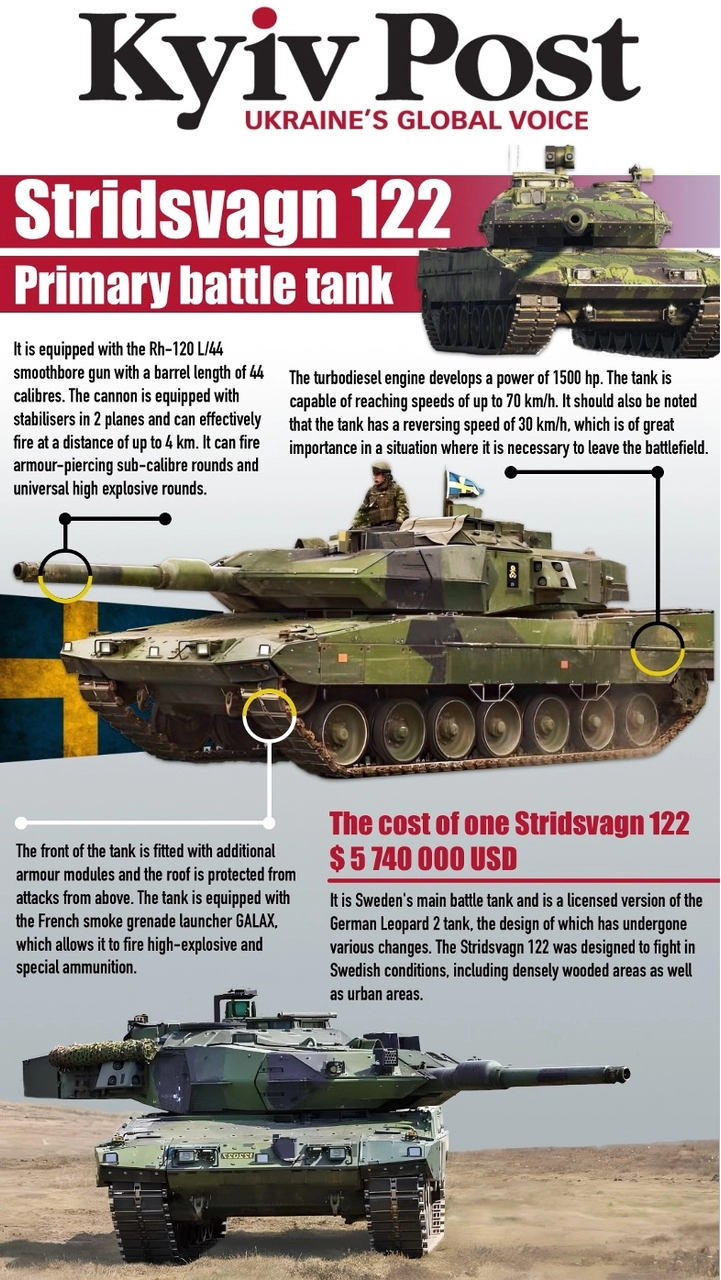Ukraine recently received 10 Stridsvagn 122s, the upgraded Swedish-modified models of the Leopard 2 tank with enhanced capabilities for all-weather employment, which are currently being used in combat on the front lines.
Sweden’s head of the Operational Department, Mats Ludvig, announced the delivery of the vehicles on the official website of the Swedish Armed Forces last month.
JOIN US ON TELEGRAM
Follow our coverage of the war on the @Kyivpost_official.
“We have given them everything we could in good material and good knowledge. Now we wish them all the best in liberating their country,” said Ludvig.
The same press release also said that the Stridsvagn has been named by some experts as “the best tank in the world.”
Sweden had a total of 120 such tanks, 10 of which were transferred to Ukraine. This is over 8 percent of the total number of tanks the Nordic country had in its inventory.
Ludwig emphasized the donation percentage of Sweden’s stockpile to show his nation’s level of commitment to assisting Ukraine.
What we know about the Stridsvagn 122 tank
The Stridsvagn 122, or “Strv 122,” is an improved version of the German Leopard 2A5 tank, which is manufactured in Sweden under license. The term “Stridsvagn” translates from Swedish as “tank.”
The Swedish armored vehicle received an improved chassis, additional armor, an updated fire control system, and the French smoke grenade launcher GALAX.
The Strv 122 has been specially designed to operate effectively in a wide variety of Swedish environments, including wooded and urban areas. Many of its adaptations would also be suitable for the Ukrainian forces in the field, especially as winter approaches.

EU Transfers €1.5 Bln Raised From Russian Assets for Ukraine
Swedish modification
In the early 1990s, the Swedish army made the decision to discontinue the development of their own tanks. To determine the best option for Sweden, a competition was held. The winner was the German Leopard 2A5 tank.
By the end of 1994, several contracts were signed to regulate the process of manufacturing and upgrading the armored vehicles for Sweden’s specific needs, both geographic and doctrinal.
In the first stage, Germany delivered 160 completed Leopard tanks with the 2A4 modification to Sweden. These tanks were designated Strv 121 and were adopted by the Swedish army.
The development of an improved and adapted version of the Leopard 2A5 was underway to meet Swedish requirements, which was re-designated the Strv 122. According to the agreement, 120 such tanks were to be delivered.
The first 29 tanks of the new model were assembled at the German factory Krauss-Maffei Wegmann.
Later, production was moved to Sweden, to the Bofors and Hägglunds factories. The assembly of the Strv 122 continued until 2002.
After receiving all the tanks of the new model, the Swedish army began to write off and return the previously delivered Strv 121 tanks to Germany. As a result, by the end of the 2000s, only 120 new Strv 122 tanks remained in service in Sweden.
Several significant improvements were made to the Strv 122 during its service life. In the early 2000s, some of the vehicles were rebuilt as part of the Strv 122B project, aimed at improving mine protection and other characteristics [another adaptation needed by Ukraine].
It was used as the basis for the Strv 122B Int., which was designed for export use abroad for various international users.
This variant received new communications and control equipment compatible with NATO standards. In addition, special measures were taken to ensure better performance of the vehicle in hot climates. Further modifications, referred to as C and D models, included various improvements to the fire control system and more.
🇸🇪 Swedish Stridsvagn 122 tank in camouflage net "Barracuda" in service with the Armed Forces of Ukraine, Kreminnaya forest. pic.twitter.com/Xf9ZRxi6Lr
— RAGE X (@ragerecon) October 3, 2023
Significant differences from the Leopard 2
The Stridsvagn 122 tank is an improved version of the German Leopard 2A5, specially adapted to the unique requirements of the Swedish Army. Although the tank retains the general architecture and some parts of the basic model, the vehicle is quite distinctive.
The Stridsvagn 122 received modern electronics and equipment, with a focus on increasing combat effectiveness through improved protection for the tank crew and more efficient fire control systems.
As a result of the improvements, the Strv 122 has become one of the most heavily protected modern tanks with the latest technologies in reactive armor shielding.
The basis of the protection is the non-explosive reactive armor (NERA), which, thanks to special materials, reliably protects the tank from the effects of both kinetic [solid metal projectile] and combined effects [armor-piercing and spallation-inducing] types of shells.
The tank is additionally equipped with composite screens that provide an additional level of protection. The Swedish version also has extra protection for the top of the turret.
Overall, the hull protection is significantly superior to the German Leopard. Destroying a Swedish armored vehicle head-on with a single shot is an almost impossible task.
The improved version of the Strv 122B features an additional underbody cover that protects the crew and critical vehicle systems from anti-tank mines [again, a feature for which Ukrainian forces have a dire need].
The Swedes also added their signature Barracuda camouflage to the B modification, which provides visual camouflage and reduces the tank's infrared footprint.
Saab’s Barracuda camouflage systems provide multi-spectral protection, which reduces the visibility of military vehicles in the ultraviolet, visual and infrared spectrums.
In addition, Barracuda not only reduces the heat footprint of the vehicle but also protects it from external heat.
The chassis has also changed. The Strv 122 tank has become more reliable due to the enhancement of the torsion shafts. The armored vehicle received shock absorbers from the German PzH 2000 artillery system.
The stabilizing electro-hydraulics were replaced with a fully electric, more durable and more fireproof system. The Swedes also partially modified the gun to allow for the use of more powerful ammunition.
President Zelenskyj besökte idag Charkivregionen där han bland annat fick kolla in en svensk Stridsvagn 122 med barracudanät och delade ut utmärkelser framför denna.🇺🇦🤝🇸🇪 Vagnschefen för #Strv122 vagnen skämtade lite och jämförde den med den sovjetiska bilen Zjiguli som var en/ pic.twitter.com/1i0IdbKnTp
— Fria Ukraina (@FriaUkraina) October 3, 2023
Armament
The main armament of the Strv 122 remains unchanged from the original Leopard 2 – the 120mm smoothbore cannon from Rheinmetall.
This cannon, in combination with extended-range capable modern electronics, is capable of effective fire at up to 4 kilometers.
While the average range for Soviet tanks is about 1,600-2,000 meters, the Strv 122 is double that.
The German cannon has exceptional ballistic characteristics. A well-trained and skilled loader can reload this cannon in just 6 seconds.
The Swedish version was equipped with two Ksp m/94 machine guns (the Swedish equivalent of the German MG3) and French-made smoke grenade launchers GALIX.
The Strv 122 is ideally suited for precise engagement of enemy vehicles, making it a sniper among tanks.
Thanks to its exceptional ballistic characteristics and fast reloading, this tank can effectively fire over long distances with a more rapid rate of fire.
The Strv 122’s advanced thermal imager and night vision device allow it to quickly detect and destroy enemy vehicles under many atmospheric conditions.
The Strv 122 tank was equipped with a completely new fire control system, which proved to be much more effective than the previous version, installed on the Leopard 2A5.
The new system has significantly improved the speed and accuracy of target detection and identification, as well as the accuracy of firing. It is now possible to fire simultaneously at multiple targets sequentially.
The fire control system is based on a modern computer platform that can simultaneously process information for all types of projectiles. It includes a thermal imager, laser rangefinder, night vision device, biaxial stabilizer and a digitally based ballistic corrector (upgraded fire control computer).
The Strv 122 tank uses the EMES-15 sight, which is based on less harmful Raman spectroscopy. The standard magnification in the daytime is ×12, and in the panoramic view - ×3.
The Strv 122 tank is renowned for its high maneuverability and mobility, just as much as the German Leopard 2A5, as the powertrain of the Swedish and German tanks is identical.
The 12-cylinder MB873 Ka-501 diesel engine with a volume of 47 liters produces 1,500 horsepower and lets the Strv 122 accelerate to 70 km/h.
The Swede also has a decent reverse speed of 30 km/h, which allows the vehicle to quickly leave the battlefield in the event of a dangerous situation. For comparison, the Soviet T-72 has a reverse speed of just 4 km/h.
The Strv 122 is not impeded by deep snow or muddy ground. If necessary, the tank can easily overcome fords up to 1.4 meters high.
The delivery of such modern and highly protected tanks, such as the Strv 122, could significantly help the Ukrainian army during the ongoing counteroffensive in certain parts of the frontline.
Sweden itself does not have many such tanks, but its contribution still provides significant assistance to Ukraine.
These tanks impress not only with their combat power but also their ability to securely protect their crew from various types of threats.
Modern Western tanks, such as the Strv 122, differ significantly from the approach that characterized the tanks of the former Soviet Union.
One of the key features of NATO tanks is the emphasis on crew safety and comfort. After all, the crew should be focused on fighting, not on surviving in difficult conditions.
The concept is that the tank crew is the most valuable resource, and all design solutions must ensure the comfortable and safe operation of tank crews.
Ukrainian crews have been trained in Sweden in all aspects of realistic combat employment of the Strv 122, according to Expressen.
The Ukrainian tanker training took place under the authority of the Swedish parliament’s mandate to provide military assistance to Ukraine, which included, among other things, Stridsvagn 122 tanks and Archer artillery systems.
You can also highlight the text and press Ctrl + Enter







